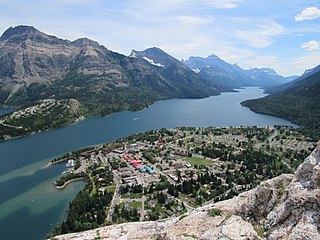
Lethbridge is a city in the province of Alberta, Canada. With a population of 106,550 in the 2023 municipal census. Lethbridge became the fourth Alberta city to surpass 100,000 people. The nearby Canadian Rocky Mountains contribute to the city's warm summers, mild winters, and windy climate. Lethbridge lies southeast of Calgary on the Oldman River.

Magrath is a town in Cardston County, Alberta, Canada. Its population was 3,281 in 2022. Magrath is 32 km (20 mi) south of Lethbridge and 242 km (150 mi) south of Calgary.

Cardston is a town in Alberta, Canada. It was first settled in 1887 by members of the Church of Jesus Christ of Latter-day Saints who travelled from Utah, via the Macleod-Benton Trail, to present-day Alberta in one of the century's last wagon migrations. The founder of the town was Charles Ora Card. The combined church and school was completed by January 29 the year following their arrival.

Milk River is a town in Alberta, Canada that is named after the Milk River which flows immediately to its south. This location results in Milk River being one of the few Canadian communities within the Mississippi River drainage system. It is 70 kilometres (43 mi) south of Lethbridge, and 16 kilometres (9.9 mi) from the Canada–United States border. It is primarily a service centre for the many farms and cattle ranches which surround it.
Coronation is a town in east-central Alberta, Canada that is surrounded by the County of Paintearth No. 18. It is located at the intersection of Highway 12 and Highway 872, approximately 100 kilometres (62 mi) west of the Saskatchewan border.

Ponoka is a town in central Alberta, Canada. It is located at the junction of Highway 2A and Highway 53, 59 kilometres (37 mi) north of Red Deer and 95 kilometres (59 mi) south of Edmonton.
Claresholm is a town located within southern Alberta, Canada. It is located on Highway 2, approximately 91 km (57 mi) northwest of the City of Lethbridge and 125 km (78 mi) south of the City of Calgary.

Stirling is a village in southern Alberta, Canada that is surrounded by the County of Warner No. 5. The village is located on Highway 4, approximately 31 km (19 mi) southeast of Lethbridge and 72 km (45 mi) northwest of the Canada–US border.

Valleyview is a town in northwest Alberta, Canada. It is surrounded by the Municipal District of Greenview No. 16 and in Census Division No. 18.
Barnwell is a village in southern Alberta, Canada. It is located 10 km (6.2 mi) west of Taber and 43 km (27 mi) east of Lethbridge on Highway 3, in the Municipal District of Taber.
Glenwood is a village in southern Alberta, Canada. It is located north of the Town of Cardston, in Cardston County. The village was named for a man named Edward Glen Wood. The founder of the village was Edward J. Wood, successor to Latter Day Saint leader Charles Ora Card, the founder of Cardston. Both Glen and Edward Wood were from Salt Lake City, Utah, and are buried in Cardston. The old name for the village was Glenwoodville until 1979.
Warner is a village in Alberta, Canada. It is surrounded by the County of Warner No. 5, approximately 65 km (40 mi) south of Lethbridge. Warner is a farming community. Warner is situated at the intersection of Highway 4 and Highway 36, about 38 km north of the Montana border and Interstate 15. Warner's nearest neighbours are the towns of Stirling and Milk River.

Cardston County is a municipal district in southern Alberta, Canada. It is located in Census Division 3 around the Town of Cardston.
Woolford is a hamlet in southern Alberta, Canada within Cardston County. It is located on Highway 503, approximately 16 kilometres (9.9 mi) southeast of Cardston between the St. Mary River and the Milk River Ridge. It is named after Thomas Woolford who came to the area in 1900.

Waterton Park, commonly referred to as Waterton, is a hamlet in southwestern Alberta, Canada within Improvement District No. 4 Waterton.
Aetna is a hamlet in southern Alberta, Canada within Cardston County, located 2 kilometres (1.2 mi) east of Highway 2, approximately 70 kilometres (43 mi) southwest of Lethbridge.
Beazer is a hamlet in southern Alberta, Canada within Cardston County, located 6 kilometres (3.7 mi) south of Highway 5, approximately 80 kilometres (50 mi) southwest of Lethbridge. It is named in 1900 after Mark Beazer who organized the first congregation of the Church of Jesus Christ of Latter-day Saints there.

Monarch is a hamlet in southern Alberta, Canada within the Lethbridge County. It is located on Highway 3A, approximately 23 kilometres (14 mi) northwest of Lethbridge. It was formerly a village, existing as such from about 1913 to about 1939.
Spring Coulee is a hamlet in southern Alberta, Canada within Cardston County, located 2 kilometres (1.2 mi) east of Highway 5, approximately 42 kilometres (26 mi) southwest of Lethbridge.
Welling Station is a hamlet in southern Alberta, Canada within Cardston County.












